#1883 explosion
Text
The Loudest Sound Ever: The Mysterious Krakatoa Explosion
Dive into the captivating tale of the Krakatoa explosion of 1883, the loudest sound ever recorded. Explore the mysteries, aftermath, and lasting impact of this monumental natural event.
Nature has always been a force to be reckoned with, showcasing its power in myriad ways. Yet, few natural events can compare in magnitude and mystery to the eruption of Krakatoa in 1883. This cataclysmic explosion didn’t just rewrite the books on volcanic eruptions; it produced the loudest sound ever recorded in human history.
A Volcano Awakens
Located in the Sunda Strait of Indonesia, between…

View On WordPress
#1883 explosion#Anak Krakatau#global climate#Krakatoa#loudest sound#magma#Sunda Strait#tsunamis#volcanic eruption
0 notes
Text
White Flag || Lloyd Hansen
Summary: You live a quiet life as the wife of a travelling salesmen with a bad moustache. You visit the country club and get manicures while Lloyd travels the world selling cleaning supplies - or at least that’s what he tells you. But there’s more secrets in this marriage than just Lloyd’s.
Warnings: 18+ only, nsfw, spanking, unprotected sex, butt plugs, canon-typical violence, pet names, guns, blood
WC: 1883

“Oh, honey, you’re home.” You gasped, pleasantly surprised to find Lloyd reclined on the sofa watching a Dodgers game. “How was your trip?”
He opened his arm up in invitation for you to join him and you cozied into his embrace as he deliberated his answer. “It was…successful.”
A cocky smile curved beneath his moustache that he refused to shave, calling it his ‘lucky ‘stache’. He was reminiscing on the thrill of his week: the explosions, the chase and finally the kill. It had been exhilarating but he still enjoyed returning home to the quiet suburban life you had built from his fortune.
He chuckled as he looked around the living room decorated with high end fixtures and gilded designs. You were the perfect housewife for him, accepting his fabricated stories without a beat and making sure he was pampered whenever he was home.
“That’s wonderful. I was going to the Hamptons with the girls from tennis this weekend but I can cancel that if you’re going to be here.” You said as you stoked chest, playing with the chain he always wore around his neck.
“I’m not home for long sunshine.” He said with a rueful smile. “I’ll be gone by Friday, another sales convention, but how about next week we go away together. Anywhere you want.”
“I’ll hold you to that.” You warned before moving to straddle his hips and graze your teeth over his throat. “First, I want you to show me how much you missed me. It’s so lonely when you go away.”
His cock stirred from your teasing, grinding your pussy over him and tipping his head back so you could leave your mark over the thick vein jutting from his neck. He caught your hips and flipped you so he could cage you beneath him, done with playing after going nearly a week without your body. His hand had not been nearly as satisfying as you and he was desperate to find his favourite place once again.
“With pleasure.” He chuckled as he tore the fabric of your dress apart and dragged your panties down your legs. You were about to kick off your shoes when he shook his head and tutted. “Leave the heels, sugar plum. You’re gonna need them.”
He pulled you to your feet and spun you away from him, pressing you forward until you were bent over the couch. He nudged your legs wider as you heard his buckle falling to the floor with his trousers and felt him slap his cock against your cunt. You moaned at the sensation of his head hitting your clit but the tight grip of his hand on your hips stopped you from being able to push back and impale yourself on it.
“Please, Lloyd, I missed you.” You begged. “You know my fingers can’t fuck me the way you do.”
“You’re such a needy slut.” Your husband chuckled, slapping a palm down your backside and watching his effects ripple across your body until you shuddered and moaned. “You’re just a whore for any attention I give you. You could probably just come from me spanking you.”
Your pussy clenched at the thought and you knew Lloyd saw as he groaned at the sight, bringing his palm swiftly down again, only closer to your cunt. The warmth of his handprint spread across your ass and your back arched as your folds ran slick with your juices.
“You look so fuckable bent over in those heels.” Lloyd smirked as he stepped back to admire your body before filling you with his cock in one hard thrust. “Fuck, oh this is my home, sunshine.”
You whined as he pulled out and left your empty once again, reaching into his suitcase that was still packed beside the sofa. “I got you a present.”
You looked over your shoulder to find him balancing a gun metal butt plug in his palm, tossing it up to snatch it from the air and show you the engraved lettering at the handle. L.H. “You know this ass belongs to me.”
He spat on the blunt end and ran it through your folds before fucking you with the bulb to get it nice and slick. You moaned at the feel of it pressing against your ass, the tight ring stretching as he coaxed it in further.
“Good girl, take it all. There you go.” He praised as the widest part passed through and your ass clenched around the thinner neck with a deeply satisfied cry. “Perfect. Now, where was I?”
Your head fell back in ecstasy as he eased his way back into you and he was acutely aware of how tight you were with both holes filled. He tried to take it easy but within seconds he was pounding his hip against you, every thrust pushing against the butt plug and sending flashes of light blinding your vision.
“Shit.” Lloyd growled loudly as your walls fluttered around his cock and a light on the side table caught his attention. “Your phone's ringing.”
“Whoever it is can wait.” You said as you pushed back and rutted against him, needing the release that was so close. “I need my husband to fuck me until I can’t walk.”
He snapped back to his task and braced a leg up on the couch so he could get even deeper, his long cock threatening to breach into your abdomen with his furious pace. You were so close to bliss, the heat of an oncoming orgasm spreading quickly across your skin, when your phone lit up again and an alert broke you from the reverie.
“Fuck.” You swore as you dove over the couch, missing his fullness as he frowned at your disappearance. His cock was stiff and glistening with your juices as you swiped the phone off the table but not before he saw the black and red alert.
“Fuck is right.” He stated coldly as he stepped closer to you, his eyes bleeding to an ice blue as his facade was dropped. “Really, sunshine?”
“It’s not my fault you fucked up.” You shot back in defence. “You killed another asset.”
The phone buzzed in your hand - the kill order flashing across the screen waiting for you to confirm the kill.
“I have to admit, I never saw this coming, you had me fooled.” He chuckled. “You’re really good.”
“It wasn’t all an act, honey.” You smirked proudly. “The assignment was to keep an eye on you. The company suggested neighbours, I wanted you.”
“Well you got me. Now what?” He asked as he took another step closer, his cock still hard at the thought of a fight or a fuck.
You slipped the heels from your feet, the fabric of your torn dress still draped around your body. “I love you.”
“I feel a but coming on.” He said as he cracked his neck and rolled his shoulders.
“But I have a job to do.”
You knew every place that Lloyd had hidden a gun in the house and raced to the hall table. The drawer had a false bottom that had a smoke grenade as well as a SIG Sauer M18 that was always left loaded and you needed that weapon. He was quick to chase you and you felt his arm wrap around your wrist and spin you at the hall wall.
Years of playing the housewife hadn’t softened you despite the leisurely lifestyle and decadent meals at the finest restaurants. In fact, you were a regular in Lloyd’s gym when he was away and the girls at the country club loved a friendly tennis competition. You knew there was a chance you would get activated from your sleeper status but you had also hoped the call never came - you really did love Lloyd.
You caught yourself before you could smash against the antique mirror that lined the hall and you looked at the reflection to see your husband’s fierce sneer. The sight of his neck thick with tensed muscles and his gritted teeth combined with the feel of his cock pressed against your back left a breathy moan escape and fog the glass.
His eyes widened and his cock twitched, the distraction enough for you to break his hold and turn the tables. You punched the mirror and tore a shard out as you pressed your forearm to his throat, pinning him to the wall.
“Is it wrong that I’m harder than a rock right now?” Lloyd chuckled before it was cut off from the pressure you applied.
“At least you’ll die happy.” You raised the glass shard but your muscles refused to finish it. Your own hand was bleeding from holding it so tight until you screamed and stabbed it into the wall beside his head. “Fuck!”
Your hold on his throat loosened as you tried to gather the courage to complete your mission and he took the moment of weakness to kick your leg out. You stumbled sideways and winced at the pain that flared as you put weight on the hurt leg. His gait was predatory as he slowly caught up to you, taking his time enjoying the show. The pain in your leg was almost enough to detract you from the reminder of the butt plug still nestled inside your ass but each step moved it slightly in and out.
A smirk grew on his lips as he noticed the change in your breathing and the bead of your pleasure rolling down your bare thighs. “Oh, sweetheart, you look like you could use a hand. How about we finish this after we finish that?”
The temptation was indescribable as he fisted his cock and stroked its length enticingly, all the while closing the distance between you.
“How do I know you aren’t just going to kill me?”
He reached into his suit jacket hanging on the hooks along the wall, pulling out a handkerchief that was embroidered with his initials just like the gift he put in you. “It’s a truce, here’s my white flag.”
“Then after we have both finished we pick up where we left off.” You confirmed as you reached out to take the offering but he pulled it away with a pause.
“Plus recovery time.” He added. “I wouldn’t want to have the advantage because I fucked you until you can’t walk.”
“An hour should do.” You agreed and reached again only to have it pulled away.
He pursed his lips together and shook his head. “I was thinking more like 20 years.”
He dropped the flag and caught you by the waist, crashing his lips against yours as he stole any argument you might have had. Adrenaline spiked at the thought of the danger you would face, in defying the kill order you would put a target on your own back but the thrill left you hungry for the challenge.
“Do you actually think we can run for 20 years?” You asked as he backed you to a wall and lifted your injured leg up, thrusting his cock between your dripping folds.
“I’m not running.” He growled, his teeth clamping over the meat of your shoulder until you cried out. “This is my home and I’ll kill everyone who tries to take it from me.”
#lloyd hansen#lloyd hansen fic#lloyd hansen x reader#lloyd hansen smut#lloyd hansen imagine#the gray man fanfic
2K notes
·
View notes
Text
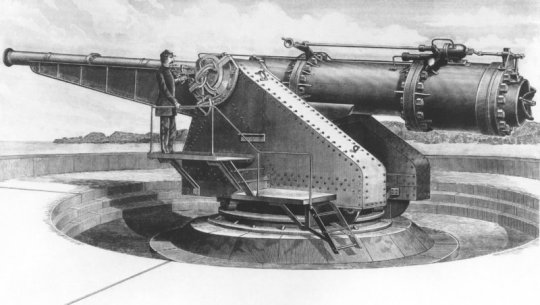

The Short Lived Pneumatic Dynamite Gun
In 1867 famed chemist Alfred Nobel patented his explosive invention; Dynamite. The new high explosive revolutionized many industries such as mining, quarrying, construction, and demolition as before the only explosive compound available was black powder, which doesn't doesn't quite have the high explosive blast of dynamite. Thus, demolition work was slow and required large amounts of black powder. It was not long after dynamite became a staple of the industrial revolution when people began to contemplate it's possible use in warfare. While dynamite is powerful, it's not very stable, and extreme caution must be practiced in it's handling and use. As a result it was not suitable for use in high explosive shells as the violent force from a firing cannon could cause the shell to detonate before even leaving the gun's barrel.
A man named D. M. Melford came up with a solution to this problem. In 1883 he demonstrated what was called a dynamite gun, which was a pneumatic cannon made to fire high explosive dynamite shells. Because it used compressed air, it could fire the shell at low velocity thus minimizing the risk or an explosive accident. In attendance for the demonstration was an American artillery officer named Edmund Zalinski, who improved upon the design and founded the "Pneumatic Dynamite Gun Company". His new "Zalinski Guns" came in a variety of calibers and utilized steam driven air compressors to charge them. Immediately the US military took interest in the concept, and began purchasing a number of the guns. In 1887 the US Navy commissioned the USS Vesuvius, a small cruiser which was armed with thee 15 inch dynamite guns which fired 500 lb high explosive shells at a range of a mile, and 200 lb shells up to 4,000 yards. The ship saw action during the Spanish American war where it's guns were used to bombard Spanish positions when the Americans landed in Cuba.


A small 8.4 inch gun was also outfitted on the USS Holland, the US Navy's first modern submarine which was commissioned in 1897.

In 1894 the US Army purchased a number of 15 inch coastal guns for use in coastal defense forts.. These 15 inch guns could fire a 50-500 lb shell around 2,000 - 5,000 yards depending on weight.
While large coastal defense guns and naval guns could easily be operated by large steam driven air compressor, such guns were impractical for field artillery as it was difficult to transport a large air compressor and use it in the field. The only piece of field artillery worth mentioning was the Sims-Dudley dynamite gun, a 2.5 inch gun which fired a 10 lb shell, and was charged using an air compressor driven by an engine which operated on the combustion of smokeless gunpowder. One was used by Theodore Roosevelt's Rough Riders during the Spanish American War, where it was generally shown to be mechanically unreliable.
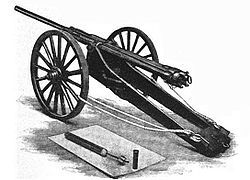
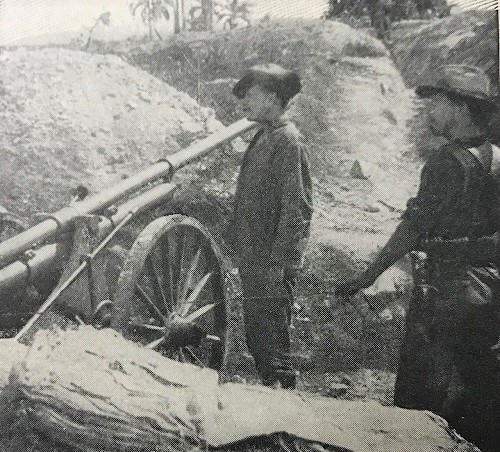
The United States was the only major power to invest in the dynamite gun. Brazil purchased only one gun, which was mounted on a warship. Other than that, no one else was interested, probably figuring that it would not be long before someone invented a stable high explosive rendering dynamite guns a dead end technology. While the United States was buying dynamite guns, everyone else was inventing stable high explosive substances. In 1863 a German chemist named Julius Wilbrand invented a yellow dye called trinitrotoluene (TNT). In 1891 another German chemist named Carl Häussermann discovered that TNT has explosive properties and is relatively stable. In 1902, the German Army began using TNT in high explosive shells from field artillery. Instantly the dynamite gun was made obsolete. Artillery using traditional propellants were cheaper, more accurate, had greater range, and without the need for an air compressor were more portable. By 1904 the USS Vesuvius had been converted into a torpedo ship, and all dynamite guns in military service had been dismantled and sold as scrap metal.
325 notes
·
View notes
Text
Rock Swag Tournament Round 1: Igneous Rocks Part 11
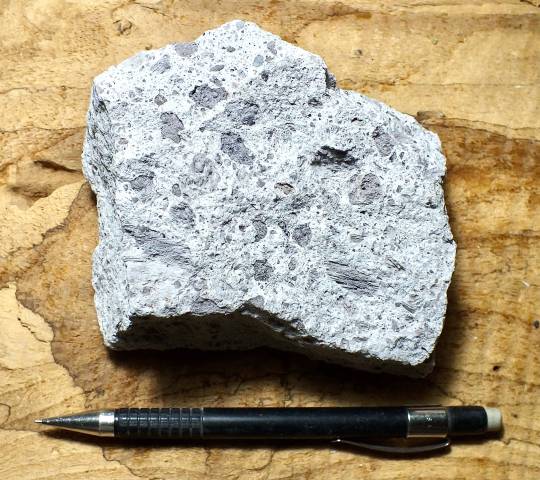

Tuff is an igneous rock...or maybe a sedimentary rock based on who you ask! It is made of lithified volcanic ash (lithification is the process by which particles of stuff become rock, and volcanic ash is sand grain-sized pieces of ejected volcanic matter).

Tuff generally also has pieces of all kinds of other stuff, as well. As long as stuff that is 2 mm or smaller makes up 75% of the rock, it will be considered tuff. Anything less than 75% volcanic ash, and the rock is described as "tuffaceous."
Fun fact: the Moai on Rapa Nui (Easter Island) are made of tuff! Also, according to one submitter, "this is one of the few volcanic rocks that can be made into a really lovely paint. Specifically a vaguely purplish gray" COOL!
Ignimbrite could be considered a type of tuff, but it is more specifically a rock formed from a pyroclastic flow deposit. Pyroclastic flows are one of the deadliest geological phenomena as they are burning hot clouds of gas and debris that race down the sides of volcanoes during some eruptions!
Ignimbrites can have more and larger pieces of volcanic debris, but they could also simply be tuffs that have welded due to the high heat from an eruption. Ignimbrites also may contain fiamme, which are "flame-shaped" lapilli (volcanic tephra or debris between 2 and 64 mm big) that have been flattened or sheared during deposition.

More on pyroclastic flows under the cut, because they are fascinating in that they are dangerous and I must talk about them.
Pyroclastic flows are blisteringly hot and terrifyingly fast clouds of volcanic gas and assorted tephra: volcanic material that can include ash (particles less than 2 mm), lapilli (between 2 and 64 mm), and blocks and bombs (greater than 64 mm).
They flow (violently rocket) down the side of volcanoes after explosive eruptions. You generally don't have to worry about pyroclastic flows on Kīlauea any time soon because those eruptions are mostly lava flows (which you can usually outrun). However, some of the most famous volcanic eruptions from recorded human history--Mount St. Helens in 1980, Krakatoa in 1883, and Vesuvius in 79 CE--were accompanied by pyroclastic flows.
Pyroclastic flows can be triggered a number of ways. Some examples are lava domes collapsing and causing an avalanche of sorts, part of the volcano exploding or collapsing in one direction (like Mount St. Helens), or the plume of debris and gas that is shot vertically into the air during an eruption collapsing back down to the surface (like Mount Vesuvius).
There is no outrunning a pyroclastic flow. They flow down the side of volcanoes and across the surrounding landscape at typical speeds upwards of 80 km/h (50 mph), but they can reach speeds of several hundred km/h. These clouds of debris are also several hundred degrees Celsius. You do not survive a pyroclastic flow!
If you would like to see what one of these looks like, I have two videos. Please be warned that because pyroclastic flows are so deadly, one of these two videos discusses deaths related to a specific eruption.
This video is from a documentary (I do not know the name of the film) and the beginning shows the genesis of the pyroclastic flow: the lava dome collapses and causes an avalanche. The pyroclastic flow then moves along a stream valley and close to a nearby town. CW: This video mentions the number of deaths directly related to this eruption and pyroclastic flow. There is footage of a vehicle and a person fleeing the pyroclastic flow, but the town they are in is are far enough away that the pyroclastic flow does not reach their location, and they survive. The potentially triggering part of the video begins at 0:24.
This video shows a pyroclastic flow going into the ocean. CW: As far as I can see, there are no people or animals in the path of the pyroclastic flow in this video and so there are presumably no deaths associated with this eruption.
75 notes
·
View notes
Text


On July 4, 1914 - An explosion demolished the upper stories of an apartment building in East Harlem, killing anarchist Arthur Caron and several colleagues. Caron had been among those who protested the involvement of the Rockefeller family in April's "Ludlow Massacre." It appeared that Caron and his associates were building the bomb meant to kill John D. Rockefeller Jr., when it exploded.
(The Ludlow Massacre occurred April 20, 1914, when Colorado state troops and a private force hired by a Rockefeller-owned coal mining company attacked and destroyed a tent camp of striking miners and their families.)

An official report stated that at least twenty-five people - including fourteen children and two women - perished in the massacre. Earlier reporting put the death toll at a minimum of forty-five people, with women and children accounting for thirty of those deaths.
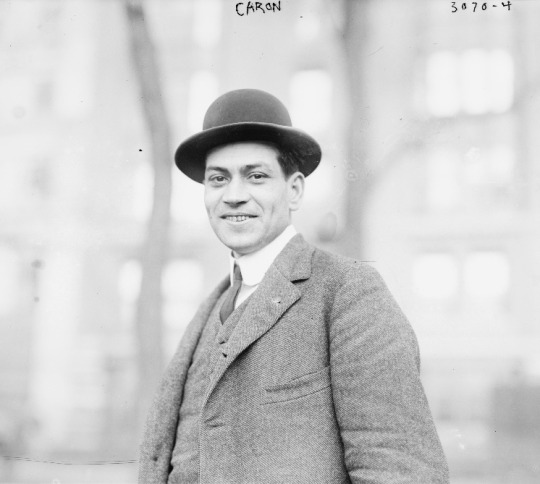

Left: Photograph shows French Canadian anarchist Arthur Caron, a member of the Industrial Workers of the World (IWW), who was killed in the Lexington Avenue bombing of July 4, 1914 in New York City.
Right: Photograph shows members of the Industrial Workers of the World (IWW), who were involved in the Lexington Avenue bombing of July 4, 1914, New York City. Group includes Arthur Caron and Charles Plunkett.


Photograph shows the destruction caused by a bomb at 1626 Lexington Avenue, New York City, which killed four people and injured many others. Anarchist conspirators were making the bomb which they intended to put at John D. Rockefeller's home in Tarrytown, New York.
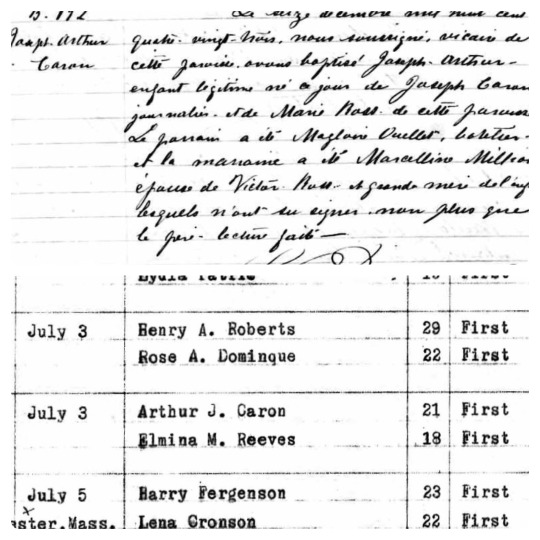
Above: Baptism record of Joseph Arthur Caron, Beauport, Quebec, Canada, 1883. His father is recorded as a day laborer.
Below: Fall River, Massachusetts marriage record for Arthur Caron and Elmina Reeves, 3July, 1905.

Indexed New York death record information.
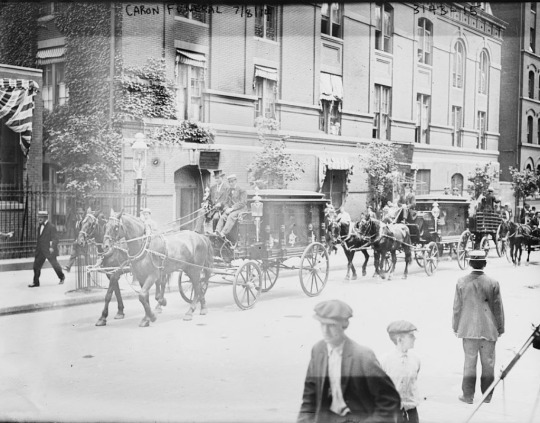
Funeral procession for French Canadian anarchist Arthur Caron, a member of the Industrial Workers of the World (IWW), who was killed in the Lexington Avenue bombing of July 4, 1914 in New York City.
More information:
#arthur caron#anarchist#french canadian#genealogy#family history#true crime#ancestry#anarchism#american politics#ancestors#crime history#family photos#genealogical#family#newspaper#john d. rockefeller#rockefeller#crime#bombing#politics#radical politics#progressive politics#canadian#fall river#new york city#new york#manhatten#anarchy
20 notes
·
View notes
Text

Erich Heckel
Two men at the table, 1912
Erich Heckel (Döbeln 1883 - 1970 Radolfzell (Lake Constance))
Oil on canvas
According to Erich Heckel's own report, his painting illustrates a scene from Fyodor Dostoyevsky's novel The Idiot: Two men fight over a beloved woman. The tense and threatening conversation situation is illustrated by Heckel by a narrow image space, broken color values and black, hard-edged contour lines. However, the presentation also addresses the increasing conflicts in the artist community "Brücke", in particular the sharp relationship between the friends Ernst Ludwig Kirchner and Heckel, whose portraits can be seen in the picture. One point of contention was the chronicle of the "bridge" written by Kirchner, whose design is on the table between the two artists. Next to it is a knife taken from the novel, which underlines the existential explosiveness of the dispute. As a sign of passion, Heckel also quotes the corpse of Christ from the Isenheim altar of Matthias Grünewald.
Kunsthalle Hamburg
12 notes
·
View notes
Note
Prompt: that thing when you look at a geographical feature or natural phenomenon for a little too long and it suddenly hits you all at one that the world is Really Big and Really Old
I walk out my front door, thirteen hours from the fires burning up north, and can taste a forest falling to its knees. even when this earth feels too massive to measure, it's connective in its distance; its biggest sorrows carried in the same breeze. one history lesson still sticks with me: in 1883, Krakatoa, a volcano in the Sunda Strait, erupted. the force of the explosion was 13,000 times that of an atomic bomb, loud enough to be heard over steam trains or street corner arguments 3,000 miles away; later covering the earth's entire atmosphere in ash. one minute, we are countries separated by waterways and passport stamps. the next, we are one neighborhood craning to look up the street.
smoke scratches the back of my throat and I think of the windows that have stayed locked all summer; mothers washing the smell from their clothes. no matter how mammoth the earth, how tremendous the distance between us, I want to believe our history is one that can reach across to say, "I'm here. what do you need? how can I help?"
16 notes
·
View notes
Photo

A Bullet That Reached Its Destiny Years Later
Henry Ziegland thought he had dodged fate. In 1883, he broke off a relationship with his girlfriend who, out of distress, committed suicide. The girl’s brother was so enraged that he hunted down Ziegland and shot him. The brother, believing he had killed Ziegland, then turned his gun on himself and took his own life. But Ziegland had not been killed. The bullet, in fact, had only grazed his face and then lodged in a tree. Ziegland surely thought himself a lucky man. Some years later, however, Ziegland decided to cut down the large tree, which still had the bullet in it. The task seemed so formidable that he decided to blow it up with a few sticks of dynamite. The explosion propelled the bullet into Ziegland’s head, killing him.
#A Bullet That Reached Its Destiny Years Later#coincidence#paranormal#ghost and hauntings#ghost and spirits#haunted salem#myhauntedsalem
37 notes
·
View notes
Text
men be deceived with my cute little kitty yawn not knowing im about to reenact the 1883 krakatoa explosion with the big stretch that is soon to follow
12 notes
·
View notes
Text
Krakatoa explodes
One of the most powerful volcanic eruptions in recorded history occurs on Krakatoa (also called Krakatau), a small, uninhabited volcanic island east of Sumatra and west of Java, on August 27, 1883. Heard 3,000 miles away, the explosions threw five cubic miles of earth 50 miles into the air, created 120-foot tsunamis and killed 36,000 people.
Krakatoa exhibited its first stirrings in more than 200 years on May 20, 1883. A German warship passing by reported a seven-mile high cloud of ash and dust over Krakatoa. For the next two months, similar explosions would be witnessed by commercial liners and natives on nearby Java and Sumatra. With little to no idea of the impending catastrophe, the local inhabitants greeted the volcanic activity with festive excitement.
On August 26 and August 27, excitement turned to horror as Krakatoa literally blew itself apart, setting off a chain of natural disasters that would be felt around the world for years to come. An enormous blast on the afternoon of August 26 destroyed the northern two-thirds of the island; as it plunged into the Sunda Strait, between the Java Sea and Indian Ocean, the gushing mountain generated a series of pyroclastic flows (fast-moving fluid bodies of molten gas, ash and rock) and monstrous tsunamis that swept over nearby coastlines. Four more eruptions beginning at 5:30 a.m. the following day proved cataclysmic. The explosions could be heard as far as 3,000 miles away, and ash was propelled to a height of 50 miles. Fine dust from the explosion drifted around the earth, causing spectacular sunsets and forming an atmospheric veil that lowered temperatures worldwide by several degrees.
Of the estimated 36,000 deaths resulting from the eruption, at least 31,000 were caused by the tsunamis created when much of the island fell into the water. The greatest of these waves measured 120 feet high, and washed over nearby islands, stripping away vegetation and carrying people out to sea. Another 4,500 people were scorched to death from the pyroclastic flows that rolled over the sea, stretching as far as 40 miles, according to some sources.
In addition to Krakatoa, which is still active, Indonesia has another 130 active volcanoes, the most of any country in the world.
2 notes
·
View notes
Link
#atmospheric science#eruption#fluid dynamics#history#meteotsunamis#ocean waves#physics#science#tsunami#volcano
37 notes
·
View notes
Text
Feel the need to add since I've been talking about Hizashi's quirk and how deadly it is: the Krakatoa explosion of 1883 was so loud it was recorded on barometres more than 100 miles away from the source of the sound, and it's believed that anyone within a 160 kilometre radius of the explosion would've had a Bad Fucking Time. This eruption killed 30 thousand people.
The barometre that picked up the sound put it down at a whopping 174. A jackhammer, by comparison, only reaches a measly 100 decibels
The Krakatoa explosion tipped in at at least 310 decibels at the volcano itself, and completely ruptured the eardrums of a shipful of sailors who were within 40 miles of the explosion. As this shockwave travelled, the sound obviously got much quieter, but, according to Brüel & Kjær, could still be heard like cannon fire 3,000 miles away from Krakatoa itself. The loudest sound recorded since then was the Tonga eruption last year, creating a sonic boom that was heard all the way in Alaska, 3,850 miles away, and causing tsunamis to tear across the planet
And yet Krakatoa still topped it as the loudest sound ever recorded, with far more devastation following [it created tsunamis that got as high as 46 metres/151 feet and went as far as South Africa]. According to Nautilus, the human threshold for pain is 130 decibels, and every 10 decibel increase on top of that is perceived as the sound doubling IE: 130db to 140db would feel more like 130 jumping to 260 [fun fact: the sound energy actually doubles at every 3 decibel increase, just to make you more insane about the science]. So yeah. Think about those possibilities next time you come across a character whose whole superpower is making sonic sounds with their voice
#random facts#autism is good for one thing and one thing only: retaining useless trivia that is only handy for my fandom content apparently#anyway look up the krakatoa explosion it's utterly fascinating as a phenomena
6 notes
·
View notes
Text
fine here's my oc (once again I'm not American)
TW: suicidal thoughts, suicide
Leung Cheng Fai (梁正輝) was born in 1845, in China's Guangdong Province. (His family name is Leung, his given name is Cheng Fai, he goes by Fai) His family owned a small farm.
He left with his father and three brothers for America via Hong Kong to earn money in 1865, leaving behind his mother, two sisters, a wife and a year old son on the farm.
They worked on the Transcontinental Railroad from 1866 to 1869. His father and one brother died in an explosion from blowing up rocks with dynamite. He didn't get paid much (actually all the Chinese workers were paid less than the average one cause racism, but they did the jobs no one wanted to do), the working conditions were bad, and he got serious back problems. They sent most of their money back to China.
Fai settled in San Francisco with his other two brothers. Tired of construction and due to back pain, he did various jobs over the years. He waited tables, delivered goods and worked in factories.
Originally, the family only wanted to earn enough to go home rich. But as the situation got worse, he tried to get his family to the US, but didn't have enough money. His son managed to come over in 1879, but since they barely knew each other, they did not get along. Besides, his son was in boarding school. It was difficult to get his wife here due to the Page act of 1875 (Banning the entry of 'undesirables', e.g. forced labourers, prostitutes and convicts, but basically made immigration harder, especially for East Asian women), but the Chinese exclusion act signed in 1882 prohibited all Chinese from immigrating, which meant his wife and brothers' families had to wait for at least 10 more years.
Devastated at the possibility of never seeing his wife again, disillusioned with the American Dream and having tolerated discrimination for all these years since he arrived (especially the San Francisco riot of 1877), Fai sank into a deep depression and became suicidal. He decided that the government was to blame for all the misfortunes he and his people have suffered. If he killed Arthur, the man who signed the act, perhaps this would send the men in power a message to not underestimate them. Or perhaps more would rise up and fight back. Or perhaps this wouldn't change anything or make things worse, but he was too furious to think clearly. He tried to shoot Arthur in 1883. A bystander noticed his gun and cried out. Shocked, he pulled the trigger and missed. A mob cornered him on the roof of a building and he shot himself. He was 38.
He's pretty normal besides the depression. He likes music, drinking tea and sleeping. He's ok at Western and Chinese chess. He doesn't care much about politics except when it directly affects him and his family. At least the US was still slightly better than the Qing dynasty, since tensions between his family and the authorities were high over land disputes and taxes. He's more of a 'everyone in the small community sits down and decides on local matters themselves' person.
He keeps to himself most of the time but closest to Zangara and maybe Czolgosz. Hates Booth because they did it for opposite reasons.
All male subjects of Qing China were required to wear a queue. They had to shave the front of their heads and braid their long hair or faced execution for treason. When his mental state deteriorated, Fai shaved his queue and now has short hair. Like other Chinese men, he wears the traditional jacket, trousers and straw shoes(not entirely sure about the names, I'm a disgrace). But he also wore a dark grey suit, flat cap and shoes, which he wore more frequently after 1882 and at the assassination to disguise himself. He is 5'3'', brawny (he's strong af) and has a slightly bent back due to hard labour.
16 notes
·
View notes
Text
« Le Cri » de Munch : Pourquoi fait-il si peur ?L’oeuvre qui inspira le masque de Scream

Entre 1893 et 1917, le peintre norvégien, Edvard Munch, réalisa 5 versions du célèbre Skrik : 2 peintures, 1 pastel, 1 crayon et 1 lithographie. La plus connue est cette peinture à l’huile, tempera et pastel de 91 x 73,5 cm. Mais en 2002, une autre s’est vendue 120 millions de dollars aux enchères. Un record pour cette oeuvre aussi désagréable qu’un bon film d’horreur ! Mais, au fait, pourquoi Le Cri est-il si effrayant ? C’est une histoire vraie l’angoisse, Edvard Munch 1863-1944 considéré comme un des précurseurs de l’art expressionniste, a beaucoup souffert.

La tuberculose emporte sa jeune mère, alors qu’il n’a que 5 ans. Son père a 50 ans et fait preuve d’une ferveur religieuse proche du mysticisme. Il a bien du mal à élever ses cinq enfants, dont ont entre 6 ans et quelques semaines. Edvard grandit avec une santé fragile, mais c’est celui qui s’en sort le mieux. Une de ses soeurs meurt de phtisie, une autre est internée à vie pour « mélancolie » et son frère meurt de pneumonie quelques mois après son mariage. Sa vie d’adulte est chaotique : dépression nerveuse et hallucinations qu’il « soigne » à l’alcool, avant de subir une électrothérapie. Des tragédies qui marquent le travail de Munch, devenu peintre à 16 ans. La maladie, la peur de la mort, la douleur … sont des thèmes récurrents dans son oeuvre. Le Cri naît d’une crise angoisse que Munch raconte dans son journal, le 22 janvier 1892. Je me promenais sur un sentier avec deux amis le soleil se couchait tout d’un coup le ciel devint rouge sang. Je m’arrêtai, fatigué, et m’appuyai sur une clôture il y avait du sang et des langues de feu au-dessus du fjord bleu-noir de la ville mes amis continuèrent, et j’y restai, tremblant d’anxiété je sentais un cri infini qui passait à travers l’univers et qui déchirait la nature. Une peinture angoissée issue d’une âme torturée. Le visage est celui de la mort c’est l’élément le plus important de l’oeuvre. Ce visage fantomatique, que la frayeur déforme, ressemble à une tête de mort. D’après un spécialiste de Munch, il a été inspiré par une momie chachapoyas péruvienne. Le cadavre, recroquevillé en position foetale, était exposé à Paris, lors de l’Exposition Universelle de 1889. Il aurait également inspiré Paul Gauguin, pour sa peinture D’où venons-nous ? Que sommes-nous ? Où allons-nous ? (1897-1898).

Le paysage raconte une catastrophe en fond, un tourbillon de couleurs qui semble peu naturel. Pourtant, comme Munch l’a écrit dans son journal, il s’agit de la représentation d’un fjord existant. Quant à la couleur rouge du coucher de soleil, un professeur d’astrophysique l’explique par l’éruption du volcan Krakatoa. En 1883, ce volcan indonésien a provoqué une telle catastrophe que même l’Europe a été marquée. Une explosion dont le son a atteint 180 décibels à 160 kilomètres de distance !
Sachant que le seuil de douleur est fixé à 120 décibels, pas étonnant que plusieurs Indonésiens soient devenues sourds. Des vagues géantes, jusqu’à 46 mètres de hauteurDes cendres volcaniques qui montent à 80 kilomètres dans l’atmosphère, observés jusqu’en Europe et aux États-Unis
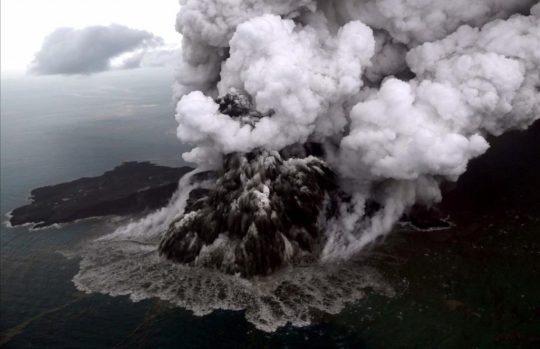
Ces particules sont sûrement responsables de la couleur du ciel observée par Munch. Rien de très rassurant pour une personne sujette aux crises d’angoisse. D’autant plus que le tableau montre une balustrade et deux hommes qui empêchent toute échappatoire ! Le cri est métaphysique. Le tableau laisse penser que c’est l’être représenté qui émet un hurlement. Pourtant, l’explication, que donne Munch dans son journal, montre que ce n’est pas le cas. Le personnage, sûrement le propre Edvard Munch, est effrayé par un cri qu’il entend. D’où cette impression qu’il se bouche les oreilles avec ses mains « je sentais un cri infini qui passait à travers l’univers et qui déchirait la nature ». Le titre d’origine du tableau était d’ailleurs Der Schrei der Natur, Le Cri de la Nature. Il serait donc une expression de l’anxiété du peintre face à des évènements imprévus et incontrôlables. C’est sans doute également une allégorie du déroulement de la vie, puisque Le Cri appartient à sa série de tableaux appellée « Frise de la Vie ».

5 notes
·
View notes
Text
Oh! Imagine Iggy doing a lecture at a university over a series of kinds of explosions. Science is fun
"So what we're going to do is recreate, in a smaller scale of course, the largest explosion ever recorded in history. It happened in 1883 on the volcanic island of Krakatoa. There was an explosion that was equivalent to roughly 200 million tons of tnt. The shockwave traveled around the earth seven times the bang was heard around 3000 miles away. Now there's a theory about how this explosion happened, it goes like this: the volcano had been erupting and throwing out lava and left behind a massive, now empty underground chamber. Sea water then filled the chamber. The walls of the chamber were still very hot, the sea water turned to steam, the pressure building up and eventually there was an explosion.
So to create that effect on s smaller scale. So we have a glass tube that controls 1 milliliter of water sealed at both ends. Now we'll heat it up with a bunsen burner. As the temperature rises the water will turn to steam and the pressure begins to build up. I'm going to put on some ear protection and you all in the audience may wish to cover your ears as this will be quite loud. Quite a boom for such a small amount of water, and it's believed that at Krakatoa that around a cubic kilometer of water was turned into steam. Eventually it reaches the point where the strength of the container is insufficient to withstand that pressure and that's where we get the explosion. This is what we call a physical explosion."
3 notes
·
View notes
Photo

Elusive atmospheric wave detected during 2022 Tonga volcanic eruption The catastrophic eruption of the Hunga Tonga–Hunga Ha’apai volcano in 2022 triggered a special atmospheric wave that has eluded detection for the past 85 years. Researchers from the University of Hawai‘i (UH) at Mānoa, Japan Agency for Marine–Earth Science and Technology (JAMSTEC), and Kyoto University relied on state-of-the-art observational data and computer simulations to discover the existence of Pekeris waves—fluctuations in air pressure that were theorized in 1937 but never proven to occur in nature, until now. The eruption in the South Pacific earlier this year released what was likely the most powerful explosion the world has experienced since the famous 1883 eruption of Mt. Krakatau in Indonesia. The rapid release of energy excited pressure waves in the atmosphere that quickly spread around the world. The atmospheric wave pattern close to the eruption was quite complicated, but thousands of miles away the disturbances were led by an isolated wave front traveling horizontally at over 650 miles an hour as it spread outward. The air pressure perturbations associated with the initial wave front was seen clearly on thousands of barometer records throughout the world. Watch an animation of the global atmosphere after the Tonga eruption “The same behavior was observed after the Krakatau eruption and in the early 20th century a physical theory for this wave was developed by the English scientist Horace Lamb,” said Kevin Hamilton, emeritus professor of atmospheric science at the UH Mānoa School of Ocean and Earth Science and Technology. “These motions are now known as Lamb waves. In 1937, the American-Israeli mathematician and geophysicist Chaim Pekeris expanded Lamb’s theoretical treatment and concluded that a second wave solution with a slower horizontal speed should also be possible. Pekeris tried to find evidence for his slower wave in the pressure observations after the Krakatau eruption but failed to produce a convincing case.” In the recent study, published in the Journal of the Atmospheric Sciences, the team of scientists applied a broad range of tools now available including geostationary satellite observations, computer simulations and extremely dense networks of air pressure observations to successfully identify the Pekeris wave in the atmosphere following the Tonga eruption. Lead author, Shingo Watanabe, deputy director of the JAMSTEC Research Center for Environmental Modeling, performed computer simulations of the response to the Tonga eruption. “When we investigated the computer simulated and observed pulses over the entire Pacific basin, we found that the slower wave front could be seen over broad regions and that its properties matched those predicted by Pekeris almost a century ago,” said Hamilton. Once the Pekeris wave was identified in the post-eruption aftermath the researchers realized that this result had more general implications for the motions in the atmosphere. Specifically, they predicted that there should be set of corresponding global oscillations or modes of the atmosphere on times scales of several hours to days. Analysis of long records of atmospheric pressure by study co-author Takatoshi Sakazaki, associate professor in the Graduate School of Science of Kyoto University, revealed the presence of the predicted set of oscillations. “In our paper we propose a standard terminology of Lamb wave and Pekeris wave for the two solutions,” said Hamilton. “Chaim Pekeris later became world famous and is today regarded as ‘the father of Israeli geophysics’, but he did his calculation of the volcanic wave response as a very young researcher at MIT where he was known for his admiration for the earlier work of Lamb. It is fitting that our discovery and our proposed nomenclature would permanently connect Chaim Pekeris with his scientific hero, Horace Lamb.”
3 notes
·
View notes